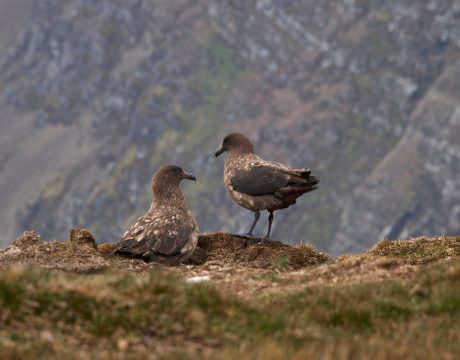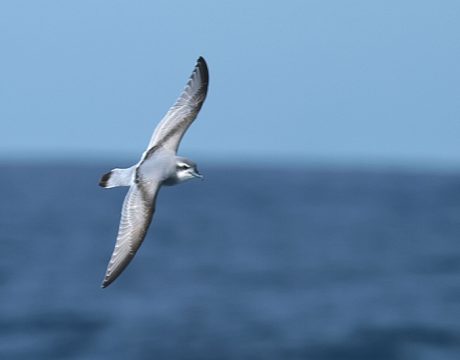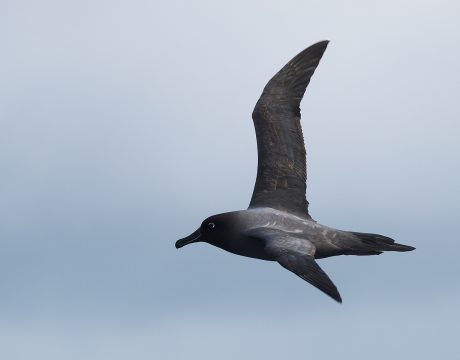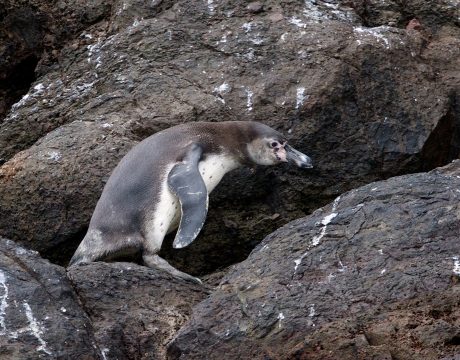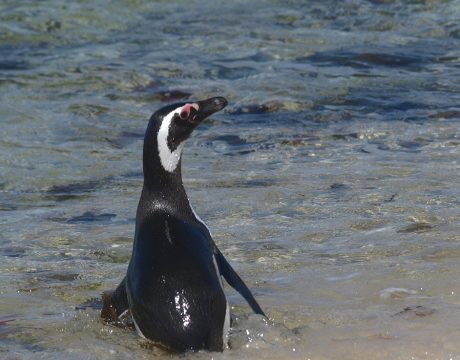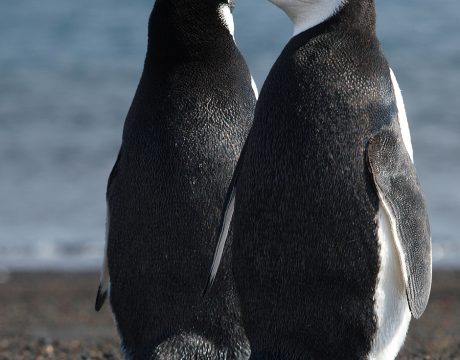Return of Bird of the Week: Brown Skua
The Skua is the bad boy of the Southern Ocean. Egg stealer, penguin chick grabber, bully, carrion eater, kleptoparasite; by human standards, this is a bad bird. They work in pairs to steal Gentoo Penguin eggs, with one distracting the penguin and the other stealing the egg. They are smart, skilled predators. But in the hour or so that WC watched this particular Gentoo colony, no Skua raid was successful. The taxonomy of Skuas is hotly disputed. Some ornithologists have as many as three species; other insist that all Skuas are subspecies of the Great Skua. Certainly there were color…
Return of Bird of the Week: Antarctic Prion
If you know the word “prion” at all you probably think of a mis-folded protein that causes neurodegenerative diseases. But it’s also a small family of seven petrel-like species, the largest of which is the Antarctic Prion. The white belly, white eyebrow, black tail tip and distinctive dark “M” shape on the back make it a pretty easy ID. Slightly smaller than petrels like the Cape Petrel, they are zooplankton and krill specialists. Their bill is adapted to filter-feeding, and they have a gular pouch like a mini-whale to assist in that filter-feeding. In flight, they are even more aerobatic…
Return of Bird of the Week: Cape Petrel
There are whole families of smaller birds, ranging from crow-sized to sparrow-sized, that spend their whole lives on the ocean, coming ashore only to breed. Petrels, Prions, Storm-petrels, Diving-petrels; they are all adapted to live on the ocean, with no need for fresh water. One of those smaller marine birds is the Cape Petrel, in Spanish the Pintado or Painted Petrel. It is probably the most common bird species on the Southern Ocean, and the easiest to see because it is an enthusiastic ship-follower. Their wings are a little under three feet long but the birds are only fifteen inches…
Return of Bird of the Week: Striated Caracara
In the Falkland Islands, the ecological role of ravens, crows and vultures is occupied by a falcon, the Striated Caracara. This is one of the larger members of the falcon family, with a wingspan of about four feet. And you can see those talons aren’t anything you’d want to mess with. In the Falkland Islands, where WC saw this species, they are called Johnny Rook, a nod to the Rook, a species of Eurasian Crow, that occupies a similar ecological niche. Intelligent, fearless and curious, WC’s problem photographing this bird was that the bird kept walking towards him, too close…
Return of Bird of the Week: Wandering Albatross
Measured by wingspan, it’s the largest bird in the world. An adult male can be 12 feet, wing tip to wing tip. This female was small, probably 10 to 10.5 feet as she flew across the path of our boat. Unlike some other species, Wandering Albatrosses don’t seem to follow ships. Perhaps they learned a lesson from that mariner the Samuel Coelridge wrote about. Watching this big girl fly by she seemed Cessna-sized. She was within binocular view for maybe 10 minutes; she never once flapped her wings. Wandering Albatross breed every other year, and don’t nest until they are…
Return of Bird of the Week: Light-mantled Sooty Albatross
A smaller member of the albatross family, the Light-manted Sooty Albatross (sometimes called the Light-mantled Albatross) is another circumpolar species. The species is “small” only in relation to other albatrosses. With a wingspan of six to seven feet and a weight of as much as eight pounds, the bird is larger than Golden Eagle and much, much more aerobatic. There are only about 58,000 birds remaining, and the species is in decline. Another victim of long-line fishing, their situation is worsened by their very slow reproductive rates. On average, birds only begin breeding when they are 8 to 15 years old,after…
Return of Bird of the Week: Black-browed Albatross
So we go from a few weeks of birds that cannot fly, to birds that can only barely land, the albatrosses. The Black-browed is a medium-sized member of the albatross family, with a wing span of seven to eight feet. This bird lives in the air, landing on the ocean only when the wind dies, something that doesn’t happen often in the Southern Ocean. It comes to land only to breed. It is a magnificent flier and an enthusiastic ship-follower. WC watched the birds from the stern of his ship as they pirouetted across the sky, flying fractions of an…
Return of Bird of the Week: Humboldt Penguin
Most folks think of penguins as Antarctic birds. And, for the most part, they are. But like most things involving birds, there are exceptions to every rule. For penguins, one exception is the Humboldt Penguin, which ranges within a few degrees south of the equator. All of the Humboldt Penguins WC has seen and photographed have been from a small boat bouncing in the waves and chop off the coast of South America. So the photos aren’t all that wonderful. As you might guess from its appearance, it’s a cousin to the Magellanic Penguin that was featured last week. The…
Return of Bird of the Week: Magellanic Penguin
This is late going up. Sorry. WC will stay with penguins just a little bit longer because flightless birds are cool, too. The Magellanic Penguin is unusual in several ways. First, it is the only species of bird in the range that has a breeding colony protected by land mines. You can’t make this stuff up. The Magellanic Penguins’ range includes the Falkland Islands in the South Atlantic. In the Argentine-Britain War in 1982, the Argentines placed land mines on several beaches. One of those beaches was the site of a large Magellanic Penguin colony, empty of penguins at the…
Return of Bird of the Week: Chinstrap Penguin
The thing is, it really does look like a chinstrap, holding that black “helmet” on to their heads. That thin line of black feathers gives the species its name, although they are also called Stonecrackers for the harshness of their calls. This is circumpolar species, with an estimated world population of about 8 million birds. They are dietary generalists, feeding on krill, squid, shrimp and small fish, which gives them an advantage over some of their more specialist cousins. When WC was at this small colony on Deception Island in early December, courtship was just getting started and the birds…





